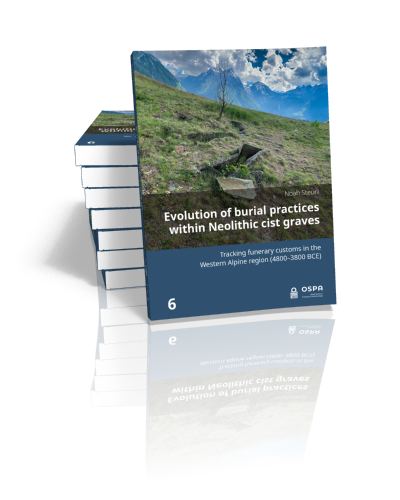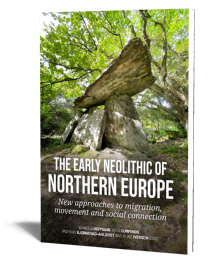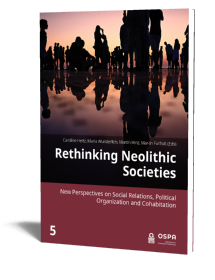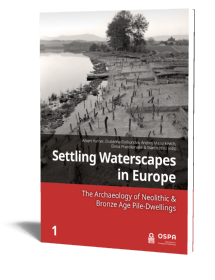Evolution of burial practices within Neolithic cist graves
Tracking funerary customs in the Western Alpine region (4800–3800 BCE)
Noah Steuri | 2025

Evolution of burial practices within Neolithic cist graves
Tracking funerary customs in the Western Alpine region (4800–3800 BCE)
Noah Steuri | 2025
Paperback ISBN: 9789464280876 | Hardback ISBN: 9789464280883 | Imprint: Sidestone Press Dissertations | Format: 210x280mm | 280 pp. | Open Series in Prehistoric Archaeology 6 | Series: OSPA: Open Series in Prehistoric Archaeology | Language: English | 126 illus. (bw) | 69 illus. (fc) | Keywords: archaeology; neolithic; stone cist graves; burial practices; Western Alps; funerary customs; chronology; radiocarbondating | download cover | DOI: 10.59641/k93665nw | CC-license: CC BY-ND 4.0
Read online or downloaded 695 times
-
Digital & Online access
This is a full Open Access publication, click below to buy in print, browse, or download for free.
-
Buy via Sidestone (EU & UK)
-
Buy via our Distributors (WORLD)
For non-EU or UK destinations you can buy our books via our international distributors. Although prices may vary this will ensure speedy delivery and reduction in shipping costs or import tax. But you can also order with us directly via the module above.
UK international distributor
USA international distributor
-
Bookinfo
Paperback ISBN: 9789464280876 | Hardback ISBN: 9789464280883 | Imprint: Sidestone Press Dissertations | Format: 210x280mm | 280 pp. | Open Series in Prehistoric Archaeology 6 | Series: OSPA: Open Series in Prehistoric Archaeology | Language: English | 126 illus. (bw) | 69 illus. (fc) | Keywords: archaeology; neolithic; stone cist graves; burial practices; Western Alps; funerary customs; chronology; radiocarbondating | download cover | DOI: 10.59641/k93665nw | CC-license: CC BY-ND 4.0
Read online or downloaded 695 times

We will plant a tree for each order containing a paperback or hardback book via OneTreePlanted.org.
In the 5th millennium BCE, the first farming societies in the Western Alps developed unique burial practices characterized by Chamblandes-type graves. These box-shaped graves, constructed from stone slabs or wooden planks, have intrigued archaeologists since the 19th century, particularly around Lake Geneva and the Upper Rhône Valley. This study delves into the origins, spread, and distinctive characteristics of these graves, especially their transalpine significance with an extensive focus on previously under-researched areas like the Italian Aosta Valley or the German-speaking part of Switzerland.
By significantly increasing the number of available radiocarbon dates, as well as comprehensively analyzing the grave goods and the treatment of human remains in the context of funerary practices, the study provides new insights into the chronology and regional variations of Chamblandes-type graves. This research reveals the contemporaneous emergence of the use of these graves in several Alpine valleys and the southern shore of Lake Geneva around 4800 BCE, as well as providing evidence for the process of their subsequent spread and sharp decline in use after 4000 BCE.
The findings reveal shared practices among these early farming communities, yet also indicate distinct funerary customs between inner Alpine valleys and the Swiss Plateau. Highlighting that local prehistoric societies in the Western Alpine region reacted similarly to the death of an individual within the community, as expressed by grave architecture and the treatment of human remains. Demonstrating additionally, that the Alps should not be understood as barriers, but as a conduit for social exchange and interaction across valleys and mountain passes more than 6000 years ago. This nuanced understanding is essential for future research, setting the stage for studies on the social structure, mobility, and diet of these Neolithic populations through paleogenetic and isotopic analyses.
Foreword
(Albert Hafner, Marie Besse)
1. Introduction
1.1. Opening remarks
1.2. Research aims
2. Background
2.1. Research of Western Alpine Neolithic cist graves
2.1.1. Defining Chamblandes-type graves
2.1.2. History of research
2.1.3. State of the research
2.2. Archaeological context in the research area
2.2.1. Mesolithic and Early Neolithic burials in the Western Alpine region
2.2.2. Settling the landscape and intra-Alpine mobility
2.2.3. Pottery styles in the Western Alpine region (4500–3800 BCE)
2.3. Concepts of burial archaeology
2.3.1. Terminology regarding burial practices
2.3.2. Rituals, grave goods, and gender
3. Methods
3.1. Research area and geographical zones
3.2. Evaluation and choice of sites
3.3. Assessment approaches
3.3.1. Radiocarbon dating
3.3.2. Evaluation of burial practices
3.3.3. Evaluation of grave goods
4. Evaluated sites
4.1. Aosta Valley
4.1.1. Quart, Vollein
4.1.2. Villeneuve, Champ Rotard
4.1.3. Montjovet, Fiusey
4.1.4 Outlined sites
4.2. Tarentaise Valley
4.2.1. Aime, Le Replat
4.2.2. Bourg-Saint-Maurice, Le Châtelard
4.2.3. Outlined site
4.3. Upper Rhône Valley
4.3.1. Saint-Léonard, Les-Bâtiments
4.3.2. Sion, Place et Rue des Remparts
4.3.3. Outlined sites
4.4. Lake Geneva, southern shore
4.4.1. Thonon-les-Bains, Genevray
4.4.2. Outlined site
4.5. Lake Geneva, northern shore
4.5.1. Corseaux-sur-Vevey, En-Seyton
4.5.2. Outlined sites
4.6. Swiss Plateau
4.6.1. Lenzburg, Goffersberg
4.6.2. Däniken, Studenweid
4.6.3. Outlined sites
4.7. Peripheral sites
4.7.1. Niederried, Ursisbalm
4.7.2. Chiomonte, La Maddalena
4.7.3. Montagnieu, Grotte-du-Souhait
5. Radiocarbon dates of Western Alpine cist graves
5.1. Available radiocarbon data
5.2. Sampling strategy
5.3. Bone sample treatment
5.4. Results
6. Burial practices within Western Alpine cist graves
6.1. Spatial organisation of grave sites
6.2. Treatment of human remains
7. Grave goods within Western Alpine cist graves
7.1. Reported grave goods within the assessed sites
7.2. Origin of raw material
7.2.1. Flint
7.2.2. Jet
7.2.3. Seashells
7.3. Typological evaluation
7.3.1. Pottery
7.3.2. Selected axe types
7.3.3. Selected limestone beads/buttons
7.3.4. Shell bracelet (and imitations)
7.3.5. Boar-tusk pectoral
8. Discussion of results
8.1. Chronology and spread of Western Alpine cist graves
8.1.1. Discussion of radiocarbon results
8.1.2. Aspects potentially affecting the radiocarbon dates
8.1.3. Modelling the emergence and spread of Neolithic cist graves
8.2. Evolution of burial practices within Western Alpine cist graves
8.3. Regionality and chronology of grave goods
9. Interpretative approach of Chamblandes-type cist graves
9.1. Proposing distinct funerary customs
9.2. Chamblandes-type cist graves beyond the Western Alps?
9.2.1. Group Finale Ligure
9.2.2. Group Massif Central
9.2.3. Neolithic burial types of northwestern Italy and south-central France
9.2.4. Scope of the Chamblandes-type cist graves
9.3. Social considerations
9.3.1. Ramifications of funerary customs
9.3.2. Emergence of necropolises and megalithic elements
9.3.3. Who built Chamblandes-type cist graves?
10. Synthesis
Acknowledgements
References

Dr. Noah Steuri
Noah Steuri (https://orcid.org/0000-0001-9735-9092) is a Swiss prehistoric archaeologist. His dissertation at the Institute of Archaeological Sciences of the University of Bern (Switzerland) was funded by the Swiss National Science Foundation and focused on Neolithic graves and burial practices in the Alps of Switzerland, France, and Italy. It addressed longstanding research gaps and provided new chronological insights, revealing crucial data about interactions of Alpine Neolithic communities. His additional interest in integrating Virtual Reality into the analysis of prehistoric structures got him awarded a postdoc project at the McDonald institute for Archaeological Research and the Cambridge Open Reality and Visual AI Laboratory of the University of Cambridge (UK), where he will further develop this cutting-edge methodology covering various megalithic monuments throughout Western Europe.
Abstract:
In the 5th millennium BCE, the first farming societies in the Western Alps developed unique burial practices characterized by Chamblandes-type graves. These box-shaped graves, constructed from stone slabs or wooden planks, have intrigued archaeologists since the 19th century, particularly around Lake Geneva and the Upper Rhône Valley. This study delves into the origins, spread, and distinctive characteristics of these graves, especially their transalpine significance with an extensive focus on previously under-researched areas like the Italian Aosta Valley or the German-speaking part of Switzerland.
By significantly increasing the number of available radiocarbon dates, as well as comprehensively analyzing the grave goods and the treatment of human remains in the context of funerary practices, the study provides new insights into the chronology and regional variations of Chamblandes-type graves. This research reveals the contemporaneous emergence of the use of these graves in several Alpine valleys and the southern shore of Lake Geneva around 4800 BCE, as well as providing evidence for the process of their subsequent spread and sharp decline in use after 4000 BCE.
The findings reveal shared practices among these early farming communities, yet also indicate distinct funerary customs between inner Alpine valleys and the Swiss Plateau. Highlighting that local prehistoric societies in the Western Alpine region reacted similarly to the death of an individual within the community, as expressed by grave architecture and the treatment of human remains. Demonstrating additionally, that the Alps should not be understood as barriers, but as a conduit for social exchange and interaction across valleys and mountain passes more than 6000 years ago. This nuanced understanding is essential for future research, setting the stage for studies on the social structure, mobility, and diet of these Neolithic populations through paleogenetic and isotopic analyses.
Contents
Foreword
(Albert Hafner, Marie Besse)
1. Introduction
1.1. Opening remarks
1.2. Research aims
2. Background
2.1. Research of Western Alpine Neolithic cist graves
2.1.1. Defining Chamblandes-type graves
2.1.2. History of research
2.1.3. State of the research
2.2. Archaeological context in the research area
2.2.1. Mesolithic and Early Neolithic burials in the Western Alpine region
2.2.2. Settling the landscape and intra-Alpine mobility
2.2.3. Pottery styles in the Western Alpine region (4500–3800 BCE)
2.3. Concepts of burial archaeology
2.3.1. Terminology regarding burial practices
2.3.2. Rituals, grave goods, and gender
3. Methods
3.1. Research area and geographical zones
3.2. Evaluation and choice of sites
3.3. Assessment approaches
3.3.1. Radiocarbon dating
3.3.2. Evaluation of burial practices
3.3.3. Evaluation of grave goods
4. Evaluated sites
4.1. Aosta Valley
4.1.1. Quart, Vollein
4.1.2. Villeneuve, Champ Rotard
4.1.3. Montjovet, Fiusey
4.1.4 Outlined sites
4.2. Tarentaise Valley
4.2.1. Aime, Le Replat
4.2.2. Bourg-Saint-Maurice, Le Châtelard
4.2.3. Outlined site
4.3. Upper Rhône Valley
4.3.1. Saint-Léonard, Les-Bâtiments
4.3.2. Sion, Place et Rue des Remparts
4.3.3. Outlined sites
4.4. Lake Geneva, southern shore
4.4.1. Thonon-les-Bains, Genevray
4.4.2. Outlined site
4.5. Lake Geneva, northern shore
4.5.1. Corseaux-sur-Vevey, En-Seyton
4.5.2. Outlined sites
4.6. Swiss Plateau
4.6.1. Lenzburg, Goffersberg
4.6.2. Däniken, Studenweid
4.6.3. Outlined sites
4.7. Peripheral sites
4.7.1. Niederried, Ursisbalm
4.7.2. Chiomonte, La Maddalena
4.7.3. Montagnieu, Grotte-du-Souhait
5. Radiocarbon dates of Western Alpine cist graves
5.1. Available radiocarbon data
5.2. Sampling strategy
5.3. Bone sample treatment
5.4. Results
6. Burial practices within Western Alpine cist graves
6.1. Spatial organisation of grave sites
6.2. Treatment of human remains
7. Grave goods within Western Alpine cist graves
7.1. Reported grave goods within the assessed sites
7.2. Origin of raw material
7.2.1. Flint
7.2.2. Jet
7.2.3. Seashells
7.3. Typological evaluation
7.3.1. Pottery
7.3.2. Selected axe types
7.3.3. Selected limestone beads/buttons
7.3.4. Shell bracelet (and imitations)
7.3.5. Boar-tusk pectoral
8. Discussion of results
8.1. Chronology and spread of Western Alpine cist graves
8.1.1. Discussion of radiocarbon results
8.1.2. Aspects potentially affecting the radiocarbon dates
8.1.3. Modelling the emergence and spread of Neolithic cist graves
8.2. Evolution of burial practices within Western Alpine cist graves
8.3. Regionality and chronology of grave goods
9. Interpretative approach of Chamblandes-type cist graves
9.1. Proposing distinct funerary customs
9.2. Chamblandes-type cist graves beyond the Western Alps?
9.2.1. Group Finale Ligure
9.2.2. Group Massif Central
9.2.3. Neolithic burial types of northwestern Italy and south-central France
9.2.4. Scope of the Chamblandes-type cist graves
9.3. Social considerations
9.3.1. Ramifications of funerary customs
9.3.2. Emergence of necropolises and megalithic elements
9.3.3. Who built Chamblandes-type cist graves?
10. Synthesis
Acknowledgements
References

Dr. Noah Steuri
Noah Steuri (https://orcid.org/0000-0001-9735-9092) is a Swiss prehistoric archaeologist. His dissertation at the Institute of Archaeological Sciences of the University of Bern (Switzerland) was funded by the Swiss National Science Foundation and focused on Neolithic graves and burial practices in the Alps of Switzerland, France, and Italy. It addressed longstanding research gaps and provided new chronological insights, revealing crucial data about interactions of Alpine Neolithic communities. His additional interest in integrating Virtual Reality into the analysis of prehistoric structures got him awarded a postdoc project at the McDonald institute for Archaeological Research and the Cambridge Open Reality and Visual AI Laboratory of the University of Cambridge (UK), where he will further develop this cutting-edge methodology covering various megalithic monuments throughout Western Europe.
-
Digital & Online access
This is a full Open Access publication, click below to buy in print, browse, or download for free.
-
Buy via Sidestone (EU & UK)
-
Buy via our Distributors (WORLD)
For non-EU or UK destinations you can buy our books via our international distributors. Although prices may vary this will ensure speedy delivery and reduction in shipping costs or import tax. But you can also order with us directly via the module above.
UK international distributor
USA international distributor
- Browse all books by subject
-
Search all books

We will plant a tree for each order containing a paperback or hardback book via OneTreePlanted.org.
You might also like:
© 2025 Sidestone Press KvK nr. 28114891 Privacy policy Sidestone Newsletter Terms and Conditions (Dutch)








